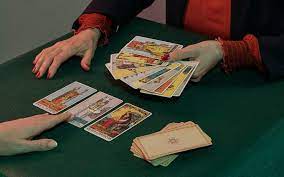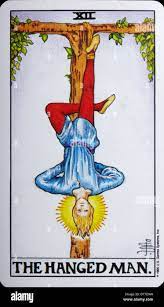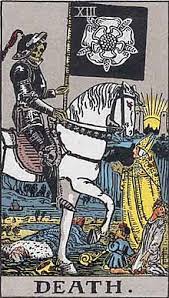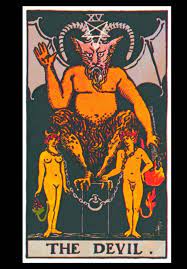This is the third in my series on Tarot. I’ve been pleasantly surprised to discover for myself how helpful the cards have become for making sense of my spiritual and material life.
Each morning, first thing, I do a Tarot reading. As previously mentioned, I “throw” three cards. The first yields a preview of the coming day, since it is meant to express the hidden “energy” of what lies before me. The second card is about gratitude; it reminds me of what I’m particularly grateful for in my long life. The final card (which I place between the other two) suggests what or whom I should incarnate during the coming day. For instance, this morning the latter was Card 14 as pictured below. I took it as a call to incarnate my patron saint, Michael the Archangel. (Look below for the explanation.)
During the day, I leave the cards out. I glance at them as the day unfolds. Their meaning deepens as I do so.
As I’ve said before, Tarot is like a 78 page book. It’s living, dynamic, and interactive — and uncanny in its practical inspiration.
What follows are the cards of focus today. Remember, the Major Arcana outline everyone’s story of passage from status as a naive “Fool” (card zero) to deeper levels of awareness.
So far the Fool we’ve been following is unaware of his/her true inner Self, a blended Magician and mysterious Priestess. The Fool has received instruction from the mother figure in his/her life (the Empress), and from a father figure (the Emperor). The Fool has also gone to school and church, where s/he’s learned community traditions and rules from representatives of a Hierophant or Pope. Then came Love, Conflict, and the early dawning of some kind of critical awareness that imparted a kind of inner Strength to think autonomously. This drove the Fool to introspection in his/her Hermit phase which brought wisdom about the nature of life as a spin of the Wheel of Fortune with an accompanying need for self-forgiveness.
The story unfolds from there in the following 5 cards:
11. Justice: From introspection and the wisdom it imparts, the Fool realizes that justice – i.e., balance between worldly achievement and care for others – is necessary to start a new chapter in life. [Here Lady Justice is pictured as a royal figure. She holds the sword of clear thinking in her right hand and the scale of justice in her left (the side closest to her heart and its intuition). The red hue of Lady Justice’s robes indicates her passion for fairness. Her golden crown and corresponding cape as well as the “halo” above the violet background drape call attention to her connection with Life’s Great Source of enlightenment and illumination. Violet is the color of integration of masculine and feminine characteristics. Achieving justice is a highly spiritual affair that combines the best of both genders. The closed-in pillars on either side of Lady Justice indicate a commitment to a path that is “straight and narrow.”]
12. Hanged Man: Since the world is committed to injustice, the Fool now finds herself/himself suspended between two contradictory worlds. As a result, s/he feels called to adopt a new upside-down perspective on life. Though uncomfortable, s/he realizes that former perceptions of “truth” were nothing but simple repetitions of “teachers’” opinions. [Notice the golden halo around the upside-down figure. This is a stage of enlightenment that is highly spiritual (indicated by the Fool’s blue tunic). Enlightenment also includes coming to grips with the passion of the Fool’s root and sacral chakras (indicated by the figure’s red tights).
13. Death: Seeing the world upside-down makes the Fool realize that spiritual growth will demand “dying” to the inherited opinions which do not belong to the inner Magician/Priestess, but to the Empress, Emperor, Hierophant, and other lesser authority figures. The Fool is now ready for rebirth, improvement, and transformation. S/he is wiser and more confident – ready to begin Life’s next chapter. [Virtually everyone who has ever heard of Tarot know of the Death Card. Close examination, however, reveals nothing to fear. Though the card can be about impending physical illness and/or death, 99.9% of the time, it’s about change — death to old ways of thinking and acting and imminent new beginnings (indicated by the sun rising in the “eastern” part of this card framed by two “Towers of Hermes” — the ancient symbol for the boundaries of the known.) That the card is about spiritual death to the past and subsequent transformation is indicated by the very prominent white horse and the white rose adorning the the black flag. The skeleton riding the horse directs attention to the most lasting part of our physical form. The dead and crownless royal figure beside the horse tells the truth that death is the great leveller; it comes to everyone regardless of positions attained during life. Then there’s the young girl turned away from the approaching horse; she seems to be in denial. Meanwhile, the small child holding out a bouquet seems to be more open to death’s approach (as young children often are). The bishop in golden robes is facing the horse directly. Is he bargaining with death? Notice the river (Styx) in the background with a small boat floating down this traditional image for life’s journey. In summary, the Death Card represents the void between death and rebirth.
14. Temperance: Preparing to enter that void involves living temperately – in peace, patience, balance, and harmony. It invites us to choose the middle path between extremes. [The powerful symbolism of this card is undeniable — especially for someone blessed with the name Michael. Notice the angel’s powerful wings tinged with red, the color of passion, energy, and activity. The angel is pouring water (the symbol of life itself) from one cup to another in a motion of giving and receiving (from the left, heart-centered hand, to the right, intellect-centered hand). Note that the angel has one foot on dry land and the other dipped in the water attempting to balance the mystical and physical realities of life. That same message of balance is indicated by the middle path behind the angel as it wends its way towards the sun. The flowers on the card are irises named after the Greek messenger-goddess. They are symbolic of hope, valor, trust and wisdom. The angel’s golden third eye under a head of golden hair also symbolize enlightenment and illumination. The gold triangle (spiritual energy) over “Michael’s” heart chakra is hemmed in by a black square (earth) again speaking of balance or temperance.
15. The Devil: But transformation and transfiguration also mean confronting the world and its extreme values of pride, covetousness, lust, anger, envy, sloth, and gluttony. It means confronting the devil, evil itself along with addictions and destructive impulses. The Fool now knows that s/he has a choice. S/he does not have to live like everyone else. [This is a very intense card – very dark (the background is entirely black). However, it signifies one’s desire to make a change. This 15th card is the first of the Major Arcana’s final seven cards that depict the seven stages of spiritual enlightenment. This initial stage is about “Consciousness of Bondage.” (If we don’t know we’re bound, we can never achieve freedom.) When the card comes up, it indicates that one is yearning for freedom. This devil card is about addictions, unhelpful habits, and giving our power away. Note that the man and woman pictured here are the same figures that appeared in card # 6, the Lovers’ Card. Here however they are bestialized with horns on their heads and now wearing long tails. The man’s tail is on fire signifying sexual passion. The woman’s tail relates to grapes perhaps connecting this picture with wine and alcohol. (As we all know, sex and alcohol are major human addictions.) Key to understanding the card is the hand gesture of the pictured devil. It is an ancient mudra that signifies “What you see is all there is.” That of course is the devil’s basic assertion – a denial of the unseen spiritual realm. It has the devil seated on a half-cube signifying his connection with half-knowledge rather than whole. This denial makes it easier for humans to sell their souls and make Faustian bargains. Unlike the Hermit’s lamp in card # 9, the devil’s torch is turned upside down setting aflame the man’s tail (passions?). In terms of escaping the devil’s thrall, it is interesting to note that the chains around the man and woman are very loose and could easily be removed. This suggests that the bondage in question is purely illusionary. Think of this card as the inverse of Tarot Card #1, the Magician, whose right hand was fully extended upward pointing to the reality of the spiritual realm. Questions suggested by this card include:
- What am I addicted to?
- What primal need are my addictions attempting to meet?
- How can I meet them in a more constructive way?
- Which addiction am I ready to break free from?
- To whom or what am I giving my freedom away?
- What fears relate to my addictions and/or unhelpful habits?
Stay tuned for my next installment on Tarot. It will address the final six cards of the Major Arcana.





